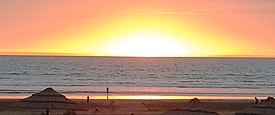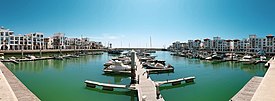This article needs additional citations for verification. (December 2022) |
Agadir
| |
|---|---|
Top: View towards Agadir Oufla, Middle: View of the ocean
Bottom: Agadir Marina | |
| Coordinates: 30°25′17″N 9°34′59″W / 30.42139°N 9.58306°W | |
| Country | |
| Region | Souss-Massa |
| Prefecture | Agadir-Ida Ou Tanane |
| Area | |
| • Land | 51.2 km2 (19.8 sq mi) |
| Elevation | 74 m (243 ft) |
| Population (2014)[1] | |
| • Total | 487,954 |
| • Rank | 10th in Morocco |
| Time zone | UTC+1 (CET) |
| Website | Agadir (in Arabic and French) |
Agadir (Arabic: أكادير, romanized: ʾagādīr, pronounced [ʔaɡaːdiːr]; Tachelhit: ⴰⴳⴰⴷⵉⵔ) is a major city in Morocco, on the shore of the Atlantic Ocean near the foot of the Atlas Mountains, just north of the point where the Souss River flows into the ocean, and 509 kilometres (316 mi) south of Casablanca. Agadir is the capital of the Agadir Ida-U-Tanan Prefecture and of the Souss-Massa economic region.
Agadir is one of the major urban centres of Morocco. The municipality of Agadir recorded a population of 924,000 in the 2014 Moroccan census.[1] According to the 2004 census, there were 346,106 inhabitants in that year[2] and the population of the Prefecture of Agadir-Ida Outanane was 487,954 inhabitants.[2]
Agadir is known for being the capital of Amazigh culture in Morocco.[3][4] It is one of the few big Moroccan cities where Tamazight, one of Morocco's two official languages, is spoken by more than half of the population. The native variety to the region, Tachelhit, is spoken by 222,000 speakers,[5] representing 53.7% of the entire population.[6] Agadir is also a place for many festivals related to Amazigh culture, such as The New Amazigh Year, celebrated on 13 January every year throughout the city, especially in the downtown area.[7][8][9] The Bilmawen Festival is another old Berber tradition celebrated in the suburbs of the city.[10] Additionally, the Issni N’Ourgh International festival is a festival for Amazigh films.[4] Agadir is also the birthplace of many of the pillars of Shilha and Amazigh music, such as Izenzaren, Oudaden, and many others.
It was the site of the 1911 Agadir Crisis that exposed tensions between France and Germany, foreshadowing World War I. The city was destroyed by an earthquake in 1960; it has been completely rebuilt with mandatory seismic standards. It is now the largest seaside resort in Morocco, where foreign tourists and many residents are attracted by an unusually mild year-round climate. Since 2010 it has been well served by low-cost flights and a motorway from Tangier.
The mild winter climate (January average midday temperature 20.5 °C/69 °F)[11] and good beaches have made it a major "winter sun" destination for northern Europeans.
- ^ a b "POPULATION LÉGALE DES RÉGIONS, PROVINCES, PRÉFECTURES, MUNICIPALITÉS, ARRONDISSEMENTS ET COMMUNES DU ROYAUME D'APRÈS LES RÉSULTATS DU RGPH 2014" (in Arabic and French). High Commission for Planning, Morocco. 8 April 2015. Archived from the original on 10 October 2017. Retrieved 29 September 2017.
- ^ a b General Census of the population and habitat 2004, Commisariat of Planning, Website: www.lavieeco.com, consulted on 7 February 2012 (in French); Archived 24 July 2012 at the Wayback Machine (in Arabic)
- ^ "جماعة أكادير تحتفي بحلول السنة الأمازيغية الجديدة2973 ببرنامج ثقافي غني ومتنوع". Agadir.ma. Archived from the original on 15 April 2023. Retrieved 15 April 2023.
- ^ a b "Agadir: Lancement de l'appel à candidature au 14è Festival Issni N'Ourgh International du Film Amazigh". Maptourisme.ma. Archived from the original on 15 April 2023. Retrieved 15 April 2023.
- ^ "Y a-t-il un " vote tachelhit " ?". Tafra.ma. 25 February 2019. Archived from the original on 21 April 2023. Retrieved 15 April 2023.
- ^ "Recensement population (RGPH) 2014". Haut Commissariat au Plan. Archived from the original on 6 October 2017. Retrieved 15 April 2023.
- ^ "More than 45,000 People Celebrate the Amazigh Year in Agadir". Mjtnews.com. 15 January 2020. Archived from the original on 15 April 2023. Retrieved 15 April 2023.
- ^ "جماعة أكادير تحتفي بحلول السنة الأمازيغية الجديدة2973 ببرنامج ثقافي غني ومتنوع". Agadir.ma. Archived from the original on 15 April 2023. Retrieved 15 April 2023.
- ^ "Nouvel An amazigh: Une semaine de festivités à Agadir". Aujourdhui.ma. 6 January 2017. Archived from the original on 15 April 2023. Retrieved 15 April 2023.
- ^ "كرنفال "بوجلود" بأكادير". Hespress.com. 12 July 2022. Archived from the original on 15 April 2023. Retrieved 15 April 2023.
- ^ "Climate (Average Weather) Data", from NOAA Station Id FM60250, Latitude: 30° 23'N Longitude: 9° 34'W Elevation: 23m Archived 16 August 2013 at the Wayback Machine.







